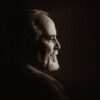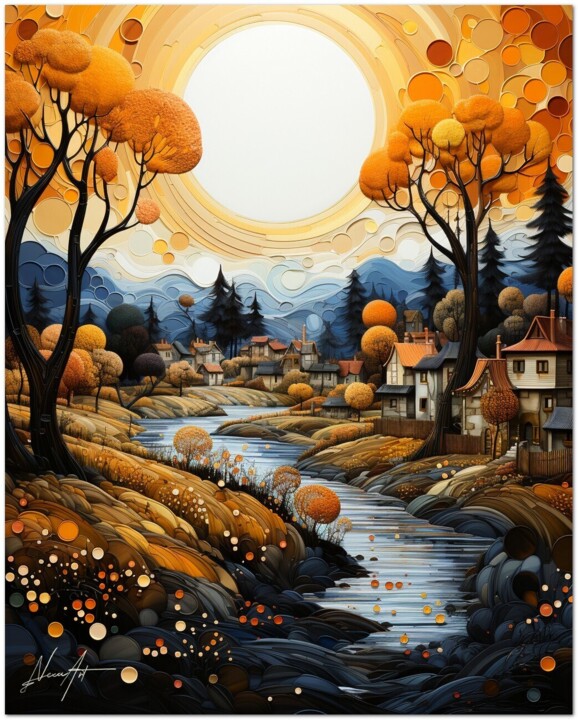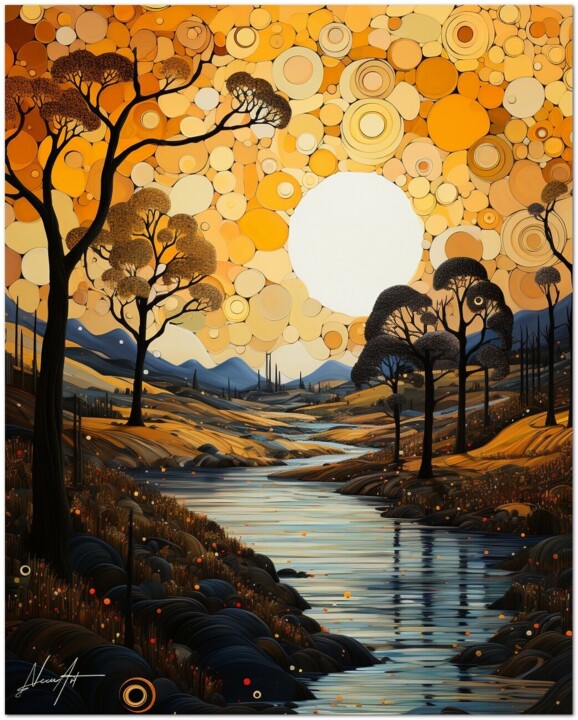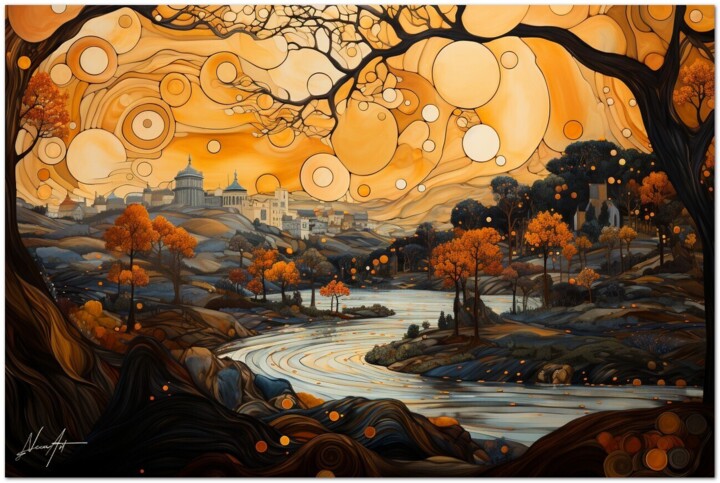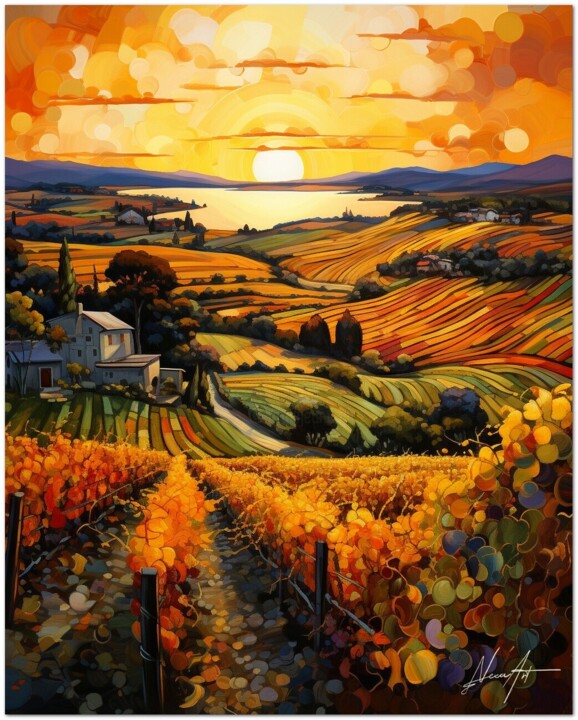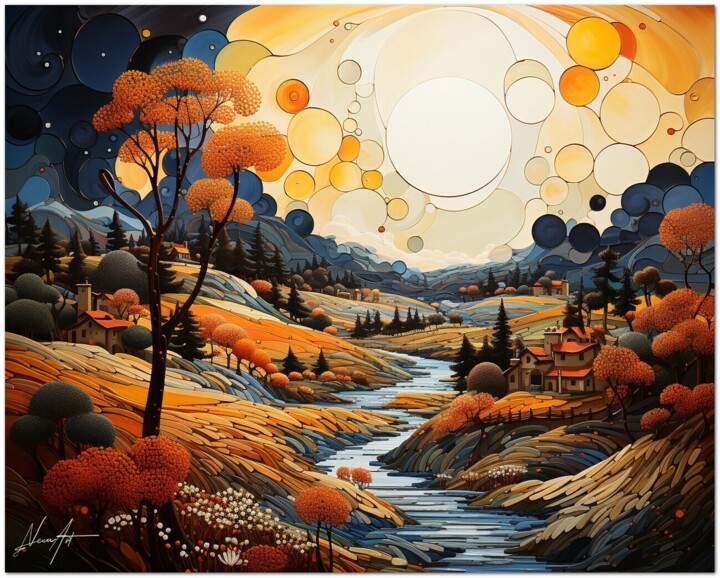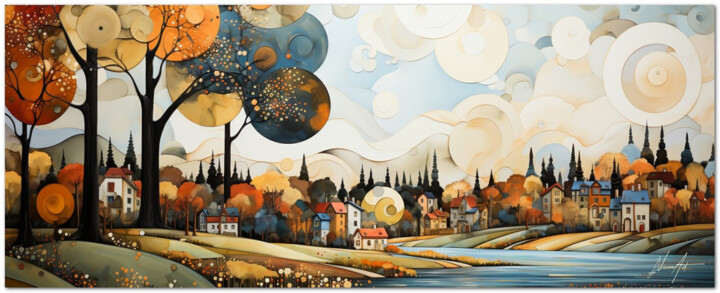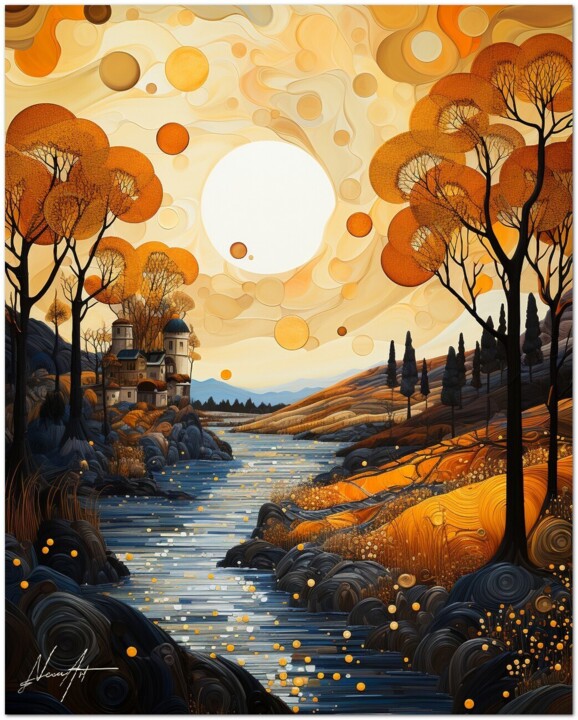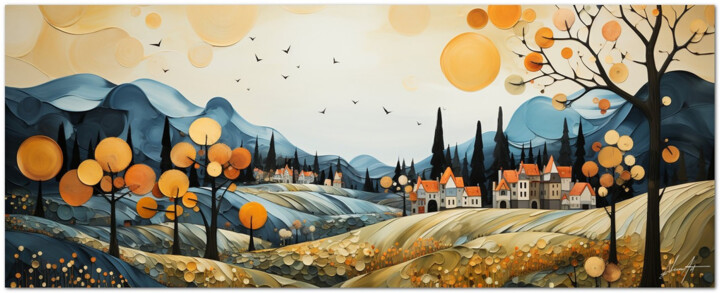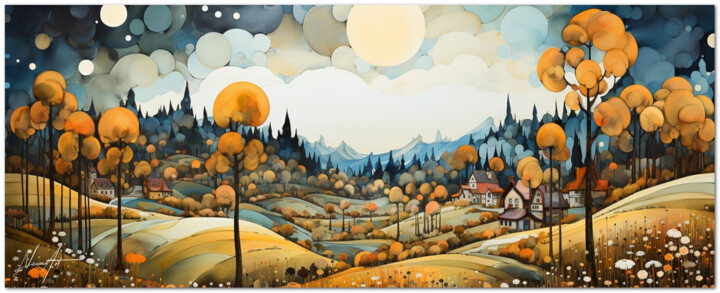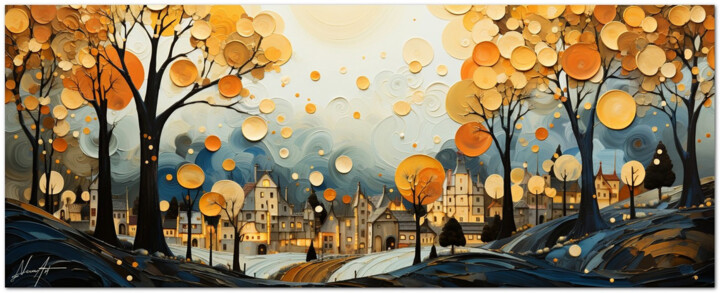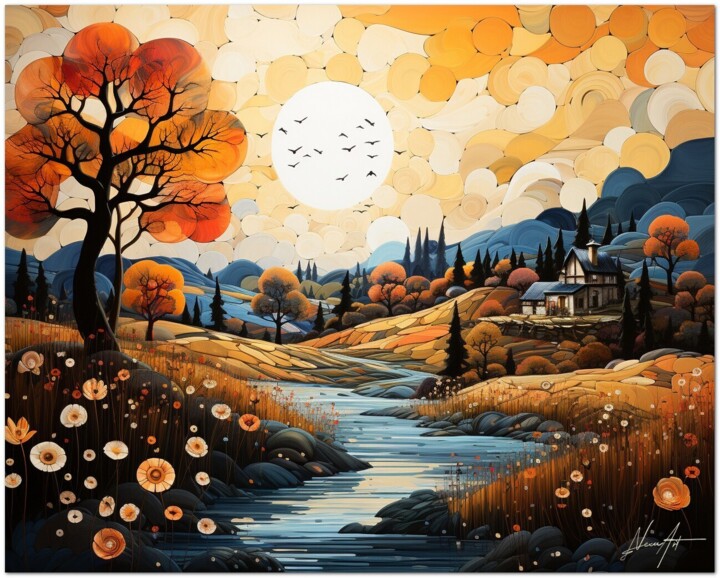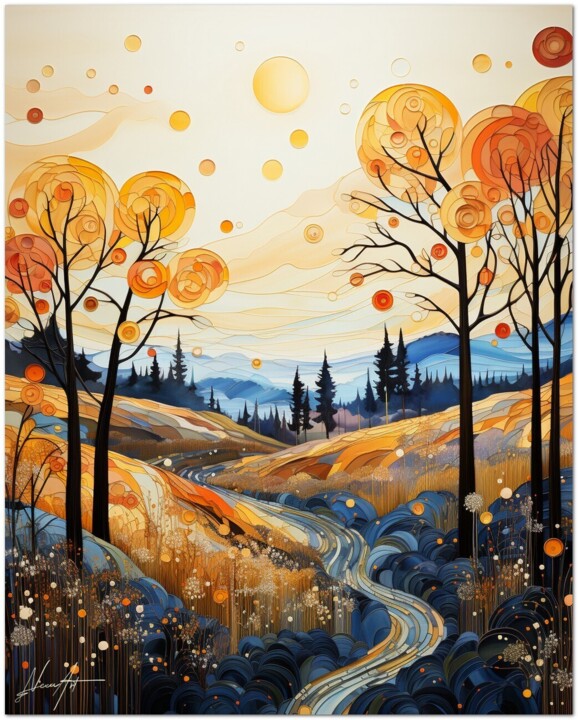What motivated you to create art and become an artist? (Events, feelings, experiences...)
My artistic inspiration stemmed from the intersection between my career as a computer consultant programmer and my passion for visual art. From a young age, I was fascinated by the limitless possibilities technology offers in the field of creative expression. Over time, this passion transformed into a commitment to explore how technology could expand the boundaries of art, leading to the creation of NEXA ART, a synthesis of my artistic vision and my love for innovation.
What is your artistic background, techniques and subjects you have experimented with so far?
My artistic journey began in the world of computing, where I developed a deep understanding of digital technologies. This allowed me to experiment with various forms of digital art, combining my technical expertise with an intuitive artistic approach. Over the years, I have explored and refined advanced digital techniques, such as image manipulation and fine art giclée printing, to create works that reflect a personal and modern interpretation of visual art.
What are the 3 aspects that differentiate you from other artists, making your work unique?
My art is distinguished by a trilogy of unique aspects. First, my bilateral experience as a computer consultant and digital artist. This dual expertise allows me to intertwine technological innovation with artistic sensibility, bringing a new and original vision to digital art. Second, I am deeply committed to creating each work as an exclusive, limited, and numbered piece. This approach not only ensures the uniqueness of each work but also enhances its collectible value, making each piece both an emotional and material investment. Third, my continuous exploration and experimentation with advanced techniques like fine art giclée printing elevate my creations beyond the boundaries of the digital canvas, enriching them with unique quality and depth.
 A photograph depicting Andrea La Martina.
A photograph depicting Andrea La Martina.
Where does your inspiration come from?
My inspiration comes from a mix of different sources. I am deeply influenced by my daily interaction with technology, a field in which I have worked for years and which continues to amaze me with its evolutions and possibilities. My personal experiences, both everyday occurrences and significant moments in my life, play a fundamental role in shaping the themes and emotions of my works. Additionally, my observation of the world around me - nature, urban architecture, human interactions - provides a constant flow of ideas and impressions. This spectrum of inspirations is clearly reflected in my works: each represents a fragment of my lived experience or a reflection on the contemporary world, filtered through my artistic eye. I strive to capture the beauty, contradictions, and complexities of our time, expressing them in a visual language that is both familiar and surprising.
What is your artistic approach? What visions, sensations or feelings do you want to evoke in the viewer?
My artistic approach is deeply rooted in the intent to fuse aesthetic beauty with intellectual and emotional stimulation. Through the use of innovative digital techniques, I aim to create works that elicit a sense of wonder and curiosity in the audience, encouraging viewers to explore deeper the meaning and message behind each piece. My creations are designed to evoke a wide range of emotions, from tranquil contemplation to surprise and fascination. I want each viewer to establish a personal connection with the work, finding echoes of their own life experience or stimuli for new reflections. In particular, I want my work to spark an internal dialogue on themes of technology and its pervasive influence in our daily existence, urging the audience to consider how digital art can expand and enrich our perception of the world.
What is the process of creating your works? Spontaneous or with a long preparatory process (technical, inspired by art classics or other)?
The process of creating my works is a balance between intuitive spontaneity and careful technical planning, where artificial intelligence (AI) plays an increasingly relevant role. My artistic journey often begins with a flash of inspiration, sparked by emotions, personal experiences, or images that capture my imagination. This initial spark transforms into a more concrete idea, which comes to life through digital experimentation.
In my studio, I use advanced digital design tools, including artificial intelligence, to explore and develop these ideas. AI helps me experiment with compositions, colors, and textures in ways that go beyond the limits of traditional human creativity. For example, I can use AI algorithms to automatically generate variations of an idea or to propose new artistic perspectives. This approach allows me to explore a vast range of creative possibilities in much shorter times.
My background in computer science and skills in digital art perfectly integrate with the use of AI. I use these tools to visualize and refine my ideas, combining inspiration drawn from art classics with technological innovation. The result is a creative process that embraces both artistic tradition and the frontiers of digital innovation.
During the final realization, I maintain a balance between artistic intuition and technical precision. Despite the strong presence of technology, the human element remains fundamental: artificial intelligence is a tool, not a substitute, for artistic vision. This allows me to create works that not only impress with their aesthetic beauty but are also rich in emotional and intellectual depth, merging seamlessly with my personal style that explores the synergy between art, technology, and humanity.
Do you use a particular working technique? if yes, can you explain it?
My work technique is a unique blend of traditional art and innovative use of technology. At the heart of my artistic practice is the use of advanced software for digital image manipulation, combined with fine art giclée printing techniques. This approach allows me to leverage the versatility of digital to transform my artistic visions into tangible realities. The process begins with the creation of digital images, where I can freely manipulate colors, shapes, and compositions. Artificial intelligence plays a fundamental role, suggesting variations and combinations that enrich my creative process. Once satisfied with the digital design, I proceed with fine art giclée printing, which allows me to bring digital creations into the physical world. This printing method, known for its high quality and longevity, allows me to accurately convey the vibrant colors and subtle details of my digital works. This technique is not just a stylistic choice, but also reflects my artistic philosophy: I believe that art should evolve along with emerging technologies, opening up new expressive avenues. Through this fusion of human creativity and digital innovation, my works become testimonies of a world where art and technology meet and enrich each other, offering the viewer an extraordinarily engaging visual experience.
What do you think of digital art? How did you get into it?
For me, digital art is an extraordinarily revolutionary frontier in the artistic field. My journey towards digital art began with my deep immersion in the world of programming and computing. While working in these fields, I was fascinated by the endless creative possibilities that digital technologies offer. Digital art has the power to blur the boundaries between reality and imagination, allowing me to explore worlds and visions otherwise unreachable with traditional means. Its fluid and dynamic nature has allowed me to express ideas and concepts in radically new ways, pushing me to explore innovative techniques and experiment with different tools. I discovered that digital art is not limited to replicating traditional techniques in digital format but offers a new expressive language. The use of digital manipulation, augmented reality, fine art giclée printing, and artificial intelligence, among others, has allowed me to expand my visual language and take my ideas to new levels of expression. Digital art, for me, represents the perfect synergy between art and science, a medium through which I can unite my technical training with my artistic vision, creating works that not only attract visual attention but also stimulate deep reflection. This approach has led me to create pieces that not only challenge the traditional perception of art but also open a dialogue on how technology is redefining the way we interact and perceive the world around us.
Are there innovative aspects to your work? Can you tell us more about them?
My works stand out for their innovative fusion of technology and artistic tradition. I use advanced digital graphics and programming techniques to reinterpret and transform traditional artistic practices. For example, the art of digital painting combined with elements of algorithmic programming allows me to create works that oscillate between the real and the digital, offering new expressive possibilities and an unprecedented level of visual detail. My creations are not just art pieces; they represent how art can evolve and adapt in the digital age, pushing the boundaries of what is possible to achieve with the fusion of art and technology.
Do you have a format or medium that you feel most comfortable with? If so, why?
My preference for digital stems from its incredible versatility and the ability to transcend the boundaries of traditional art. Working in digital is not just a technical choice, but an extension of my artistic vision. This medium offers me almost unlimited expressive freedom, allowing me to experiment with textures, colors, and shapes in ways that would be unthinkable or extremely laborious in other formats. I can quickly iterate and modify my works, exploring different variants of an idea without the fear of making irreparable mistakes or wasting materials. This process is liberating and stimulates my creativity, allowing me to approach each new work with an open and unbiased mind. Additionally, digital art allows me to integrate and experiment with emerging technologies like augmented reality and artificial intelligence. These tools open new perspectives in my art, allowing me to create immersive experiences for my audience. The interactive and multidimensional nature of these technologies offers a wider range of artistic expressions and allows me to take my ideas into unexplored territories. Another fundamental aspect of digital is its accessibility and shareability. I can easily share my work with a global audience through online platforms and social media, expanding the reach of my work well beyond the confines of a physical gallery. This immediacy of sharing and feedback allows me to interact with a wider audience and receive input that can further influence my creative process.
Are there subjects you prefer to depict?
In my work, I am particularly drawn to depicting female faces and characters that convey deep, palpable emotions to the observer. These faces are not just portraits; they are windows into the stories, experiences, and emotions of each subject. I strive to capture not only their aesthetic beauty but also the emotional intensity that resides beneath the surface. Concurrently, I dedicate myself to creating landscapes that offer new perspectives and dimensions, pushing the viewer to see the world through a different lens. These landscapes are often characterized by a play of colors and shapes that challenge traditional conventions, offering a unique and modern view of the world around us. In both cases, my goal is to evoke a reaction in the audience, inviting them to connect with the work on a deeper level.
Where do you produce your works? At home, in a shared studio, or in your own studio? And in this space, how do you organize your creative work?
My personal studio is the beating heart of my artistic activity. It is a place designed to nurture both creative inspiration and technological innovation, where ideas take shape and become tangible realities. Located in a calm and stimulating environment, my studio is a personal sanctuary that reflects my unique approach to digital art. Within the studio, I have organized the space into different functional areas. One area is dedicated to design and digital pre-visualization, where I use advanced software and artificial intelligence to develop and refine my ideas. Here, large screens and high-precision input devices allow me to manipulate images and compositions with great detail. Another area is reserved for fine art giclée printing, where my digital ideas take physical form. This materialization process requires both deep technical knowledge and artistic sensitivity. Besides the technical aspects, my studio is also a place for reflection and contemplation, surrounded by books, sketches, and artworks that inspire me. This tranquil environment is essential for my creative process, as it allows me to detach from the daily chaos and focus on my art. The organization of my studio is designed to optimize workflow and stimulate creativity, with every tool and material within reach.
Does your work involve traveling to meet new collectors, attend fairs, or exhibitions? If so, what takes you there?
Yes, as an IT consultant and programmer, I frequently travel to attend conferences, seminars, and meetings with clients. These trips allow me to stay up-to-date with the latest technological trends, expand my professional network, and collaborate with other industry experts. Each journey represents an opportunity to learn, grow professionally, and apply new knowledge and skills to my projects.
How do you envision the evolution of your work and your career as an artist in the future?
In the future, I see my artistic career as a continually evolving path, fueled by a constant commitment to exploration and innovation. My vision includes expanding my technical and artistic skills, fully embracing the opportunities offered by new technologies. I am particularly excited about the evolution of artificial intelligence and how it can be integrated into digital art to create increasingly complex and engaging expressive forms.
I plan to continue experimenting with new techniques and tools, such as augmented reality, fine art giclée printing, 3D printing, and virtual simulations, to create works that not only capture visual attention but also challenge the way we perceive and interact with art. This multidisciplinary approach will allow me to create immersive and multisensory artistic experiences.
Furthermore, I aspire to a greater presence in the international art scene, participating in exhibitions, art fairs, and collaborating with galleries and collectors around the world. These experiences will be essential for expanding my professional network and exposing my work to a broader and more diverse audience.
I also commit to collaborating with other artists and industry professionals. I firmly believe that collaboration and the exchange of ideas are fundamental for personal and professional growth. These collaborations can take various forms, from creating joint artworks to organizing workshops and exhibition projects, offering unique opportunities for mutual learning and exploring new artistic territories.
Finally, I will dedicate myself to projects that have a social and cultural impact, using my art as a tool to raise awareness on important issues and stimulate dialogue on global matters. This aspect of my career will not only enrich my artistic experience but will also allow me to contribute significantly to society and the artistic community.
What is the theme, style, or technique of your latest artistic production?
My recent artistic production is characterized by a deep immersion in the theme of human-digital interaction. In my latest works, I explore how technology alters our perception of reality and the surrounding environment. I am fascinated by the idea of how digital life influences our way of living, thinking, and feeling.
In terms of style, these works combine elements of realism and abstraction. Using vibrant colors, geometric shapes, and digitally elaborated textures, I aim to capture the fluid and sometimes overloaded essence of the digital world, contrasting it with the tangibility of the physical world. This play of opposites creates an intriguing visual dynamic, inviting the viewer to reflect on their own experience in the digital world.
Technically, these works are the result of intense experimentation with various digital graphic software and 3D printing techniques, also integrating elements generated through artificial intelligence. AI plays a key role in the creative process, allowing me to explore patterns and textures that would otherwise be unachievable with traditional methods. AI is employed not only as a creation tool but also as a source of inspiration for the theme of the works, underlining its increasingly pervasive impact on our society.
My vision is to create art that is not only aesthetically pleasing but also serves as a catalyst for reflection and dialogue. My works are designed to stimulate curiosity and imagination, inviting the viewer to contemplate the multiple facets of our existence in an increasingly digital era. Through art, I aim to explore and question the coexistence between human nature and technological innovation, opening a gateway to new understandings of our time.
Can you tell us about your most significant exhibition experience?
So far, my artistic career has focused mainly on the development and creation of digital artworks, without yet having the opportunity to physically exhibit in galleries or public shows. However, this is about to change: for 2024, I am organizing a series of exhibition events in renowned Italian galleries. These exhibitions will represent a crucial step in my artistic career, marking the transition from an exclusively online presence to a physical one, allowing me to interact directly with the public and other artists.
In the meantime, my works are available for viewing and purchase online on platforms such as Artmajeur.com and on my personal website, nexaart.com. This digital presence has allowed me to reach a global audience, attracting the interest of collectors and art enthusiasts from different parts of the world.
If you could create a famous work in the history of art, which one would you choose? And why?
If I had the opportunity to create a famous work in the history of art, I would choose without hesitation a masterpiece by Gustav Klimt. One of my favorite artists, Klimt revolutionized the concept of beauty and art with his unique style, characterized by bold use of color and intricate decorative motifs. His work "The Kiss" represents for me the pinnacle of his artistic mastery, where gold, textures, and patterns create an intensely emotional and symbolic image. If I could create a work like "The Kiss," I would strive to capture that same fusion of passion, romance, and innovation that made Klimt an icon of the art world.
If you could invite a famous artist to dinner (living or deceased), who would it be? How would you suggest spending the evening with them?
If I had the opportunity to invite a famous artist to dinner, I would undoubtedly choose Leonardo da Vinci. His insatiable curiosity and extraordinary ability to merge art, science, and technology represent for me an inexhaustible source of inspiration. The evening would be dedicated to deep and stimulating conversations, where I could immerse myself in his holistic vision of art and knowledge. I imagine discussing the infinite possibilities of digital art, sharing ideas on how technology can expand the boundaries of creativity. Surely, it would be an unforgettable experience of learning and cultural enrichment.







 Olimpia Gaia Martinelli
Olimpia Gaia Martinelli
